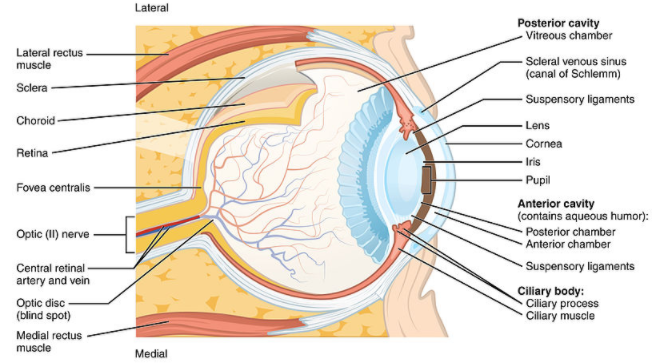
Draw a line sketch to show the image formation on the retina of the human eye.
Answer
552.9k+ views
Hint: The organ of the visual system of the human body is the eyes. They provide a vision of the ability to receive and process visual details.
Complete answer:
The human eye is a sense organ that reacts with light and allows light perception, colour vision, and depth perception and it is made up of a number of parts consisting of the Iris, Pupil, Cornea, and Retina. They provide vision, the ability to receive and process visual details.
Parts of the eye:
a) Cornea- Light is focussed commonly by the cornea. It acts like a camera lens for the human eye.
b) Iris- Iris of the eye controls the amount of light reaching the back of the eye by adjusting the size of the aperture.
c) Eye lens- Crystalline eye Lens located behind the pupil and focuses the light.
d) Pupil- It is a hole located in the centre of the iris of the eye which allows light to strike the retina.
e) Retina- Light focussed by the cornea and crystalline lens then reaches the retina, light-sensitive inner lining of the back of the eye. Its function is to receive light focussed by a lens and converting it into neural signals and sending signals to the brain for visual recognition.
Image formation: Cornea and lens of an eye together form a real image on the retina of the eye. When light passes into the eye it first passes from the cornea. The cornea acts as a convex lens because of the curved surface they begin to focus on light rays. The light then passes through the pupil and hits the lens of the eye. A lens that is also convex focused so that it hits the retina at the back of the eyeball to form an image and the image formed on the lens is real and inverted.

Note: Eyes which are a natural optical instrument detect light and convert it into electro-chemical impulses in neurons. It also gives the ability to differentiate between colours and depth.
Complete answer:
The human eye is a sense organ that reacts with light and allows light perception, colour vision, and depth perception and it is made up of a number of parts consisting of the Iris, Pupil, Cornea, and Retina. They provide vision, the ability to receive and process visual details.
Parts of the eye:
a) Cornea- Light is focussed commonly by the cornea. It acts like a camera lens for the human eye.
b) Iris- Iris of the eye controls the amount of light reaching the back of the eye by adjusting the size of the aperture.
c) Eye lens- Crystalline eye Lens located behind the pupil and focuses the light.
d) Pupil- It is a hole located in the centre of the iris of the eye which allows light to strike the retina.
e) Retina- Light focussed by the cornea and crystalline lens then reaches the retina, light-sensitive inner lining of the back of the eye. Its function is to receive light focussed by a lens and converting it into neural signals and sending signals to the brain for visual recognition.
Image formation: Cornea and lens of an eye together form a real image on the retina of the eye. When light passes into the eye it first passes from the cornea. The cornea acts as a convex lens because of the curved surface they begin to focus on light rays. The light then passes through the pupil and hits the lens of the eye. A lens that is also convex focused so that it hits the retina at the back of the eyeball to form an image and the image formed on the lens is real and inverted.

Note: Eyes which are a natural optical instrument detect light and convert it into electro-chemical impulses in neurons. It also gives the ability to differentiate between colours and depth.
Recently Updated Pages
Two men on either side of the cliff 90m height observe class 10 maths CBSE

What happens to glucose which enters nephron along class 10 biology CBSE

Cutting of the Chinese melon means A The business and class 10 social science CBSE

Write a dialogue with at least ten utterances between class 10 english CBSE

Show an aquatic food chain using the following organisms class 10 biology CBSE

A circle is inscribed in an equilateral triangle and class 10 maths CBSE

Trending doubts
Differentiate between Food chain and Food web class 10 biology CBSE

What is UltraEdge (Snickometer) used for in cricket?

What are the public facilities provided by the government? Also explain each facility

On the outline map of India mark the following appropriately class 10 social science. CBSE

Why does India have a monsoon type of climate class 10 social science CBSE

A sum of 10000 is invested at the rate of 8 per year class 10 maths CBSE




